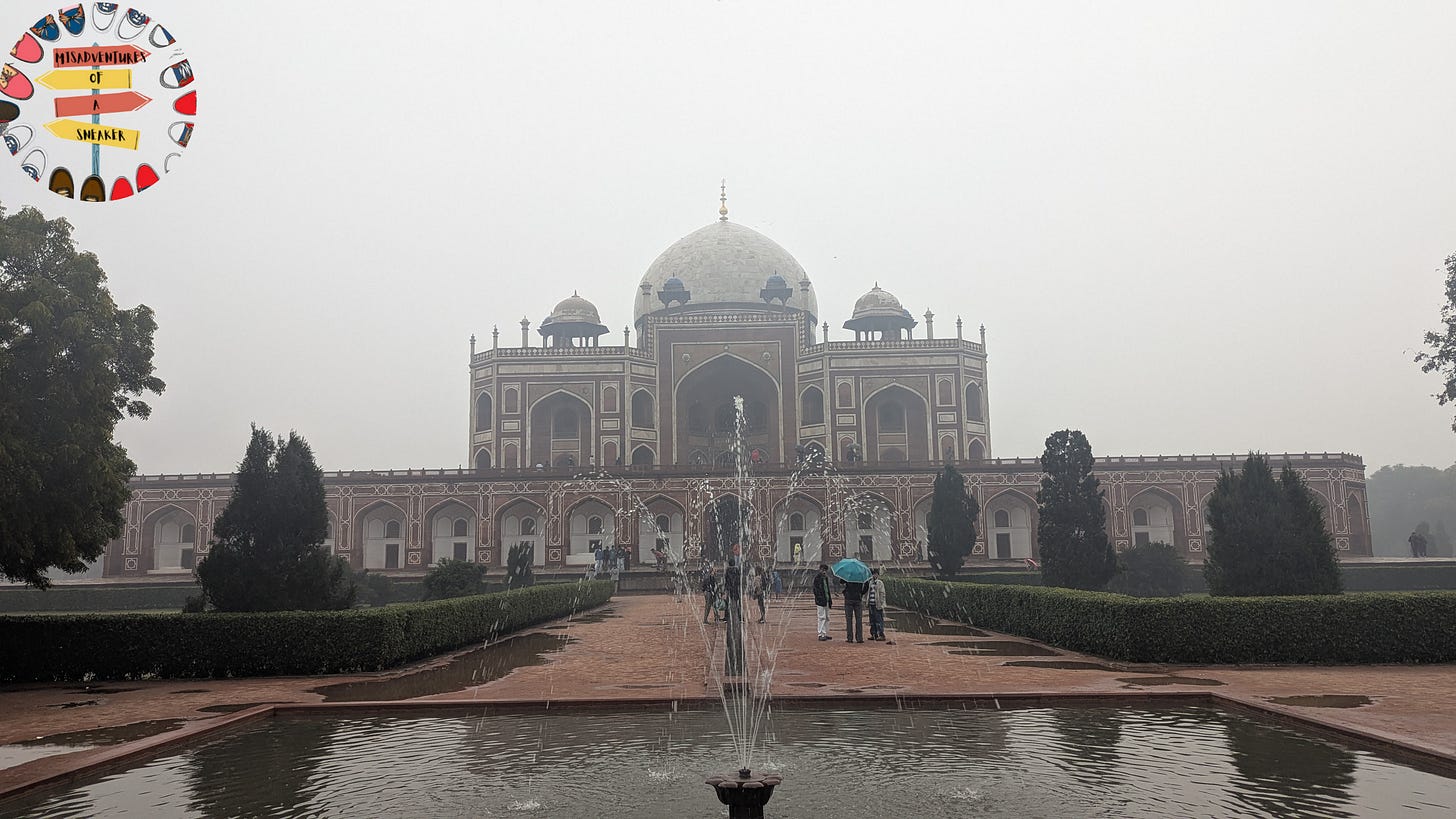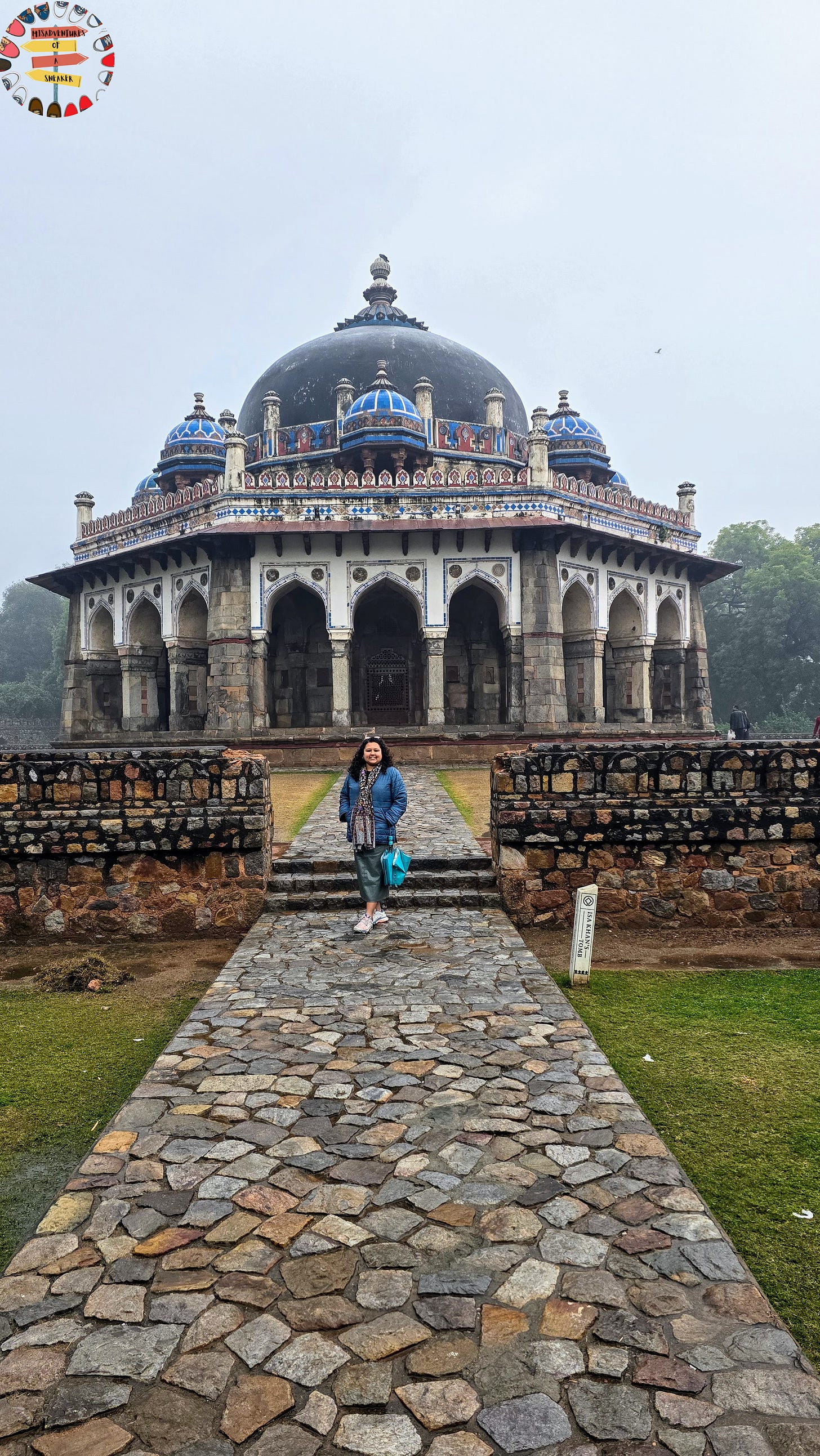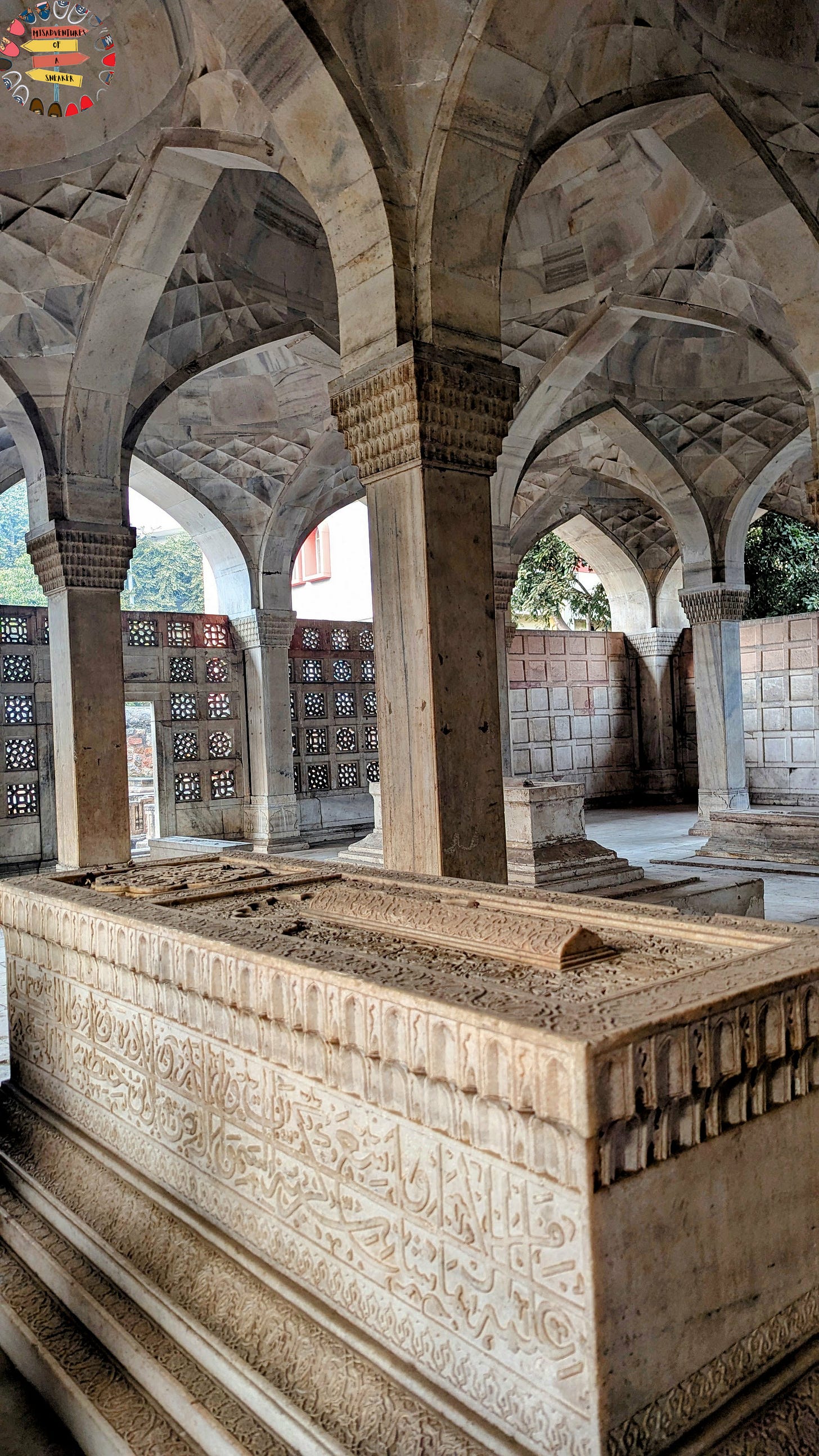Delhi Diaries: Part 2- A day in Nizamuddin
A journey through Sunder Nursery, Humayun’s Tomb, and the Sufi rhythms of Nizamuddin Dargah
Delhi Diaries: A Series of Stories
This is part-2 of my four part series on touring Delhi. Like I mentioned in my earlier blog, one of my last trips in 2024 was to Delhi, and let me tell you, I wasn’t even remotely ready for what the city had in store!
Everything about this city—its history, its vibrant streets, and its mouth-watering food—completely captivated me. Each experience was beyond anything I had imagined. Being a travel-blogger and a podcaster, I returned and started compiling all my thoughts and all the stories I heard and putting them all together in a blog. But within the first few paragraphs itself, I got the message that my newsletter was ‘near email length limit’. So get ready for the second of a four-part series, and today, we’re exploring the Nizamuddin area.
1. Sunder Nursery
We began our journey in the Nizamuddin area with a visit to Sunder Nursery—and OH MY GOD, what a magical start to the day! I remember my initial reaction to this place during my podcast episode on Delhi and I asked my guest - ‘but a nursery is a place where plants are grown and sold right, why does this place have 6 UNESCO sites within it 😮’. Well well well, this serene oasis traces its origins back to the Mughal era, when it was known as Azim Bagh. Later, under the British Raj, this bagh did have experimental plants being grown, and thus the ‘nursery’. And ‘Sunder’ because it houses the very pretty Sunder Burj, a Mughal-era tomb in the premises! So ‘Sunder Nursery’.
Today, this UNESCO World Heritage Site complex is part of a vast necropolis surrounding Humayun’s Tomb, home to several beautifully restored Mughal-era tombs and monuments. Thanks to the incredible efforts of the Aga Khan Trust, it has transformed into a world-class heritage park, blending history with unmatched natural beauty.
We started with a picnic, spending hours lounging on the manicured lawns in front of the Sunderwala Burj, basking in the peaceful scenery that transported us to another era. Once we felt that we were sufficiently sun-bathed, we set off on an ‘exploratory walk’ around the nursery. The monuments here are a treat for history buffs and casual visitors alike: Sunderwala Burj, Lakkarwala Burj (two tombs), Sunderwala Mahal (a mausoleum), elegant Mughal-era pavilions, an amphitheatre, charming Mughal gardens, and several other historical gems.

And here’s the cherry on top—just beside the Sunder Nursery entrance lies the gateway to Humayun’s Tomb, one of the top three most-visited monuments in Delhi.
2. Humayun’s Tomb
This is the very monument that set the stage for all the iconic Mughal architecture to follow—yes, even the Taj Mahal! A UNESCO World Heritage Site, Humayun’s Tomb isn’t just a historical gem but a shining example of Mughal grandeur blended with Persian elegance.
Did you know Humayun’s Tomb was the first tomb of a Mughal emperor ever built in India? It was commissioned by Humayun’s wife, Bega Begum, after his death. During their exile in Persia, she was so awestruck by the stunning Persian architecture that she insisted a Persian architect design the tomb. What’s even more fascinating? Over the years, this tomb became the resting place of more than 150 members of the Mughal dynasty!
The magnificence of the tomb is something words can’t quite capture—I’ll let the photos or videos do the talking for this one.
A video I shot as I entered the Humayun’s tomb complex. Video © Misadventures of a Sneaker

And if that wasn’t enough, there’s now a new underground museum within the complex. It’s sleek, aesthetic, and packed with fascinating tidbits about the tomb and the lives of the Mughals. Even if history isn’t your thing, this museum is worth at least an hour of your time. Watch the short film they play, explore the artifacts, and soak in the stories that bring this era to life.
Speaking of stories, here’s one I found absolutely mind-blowing: When Humayun lost the kingdom of Hindustan, he sought help from the Persian ruler, Shah Tahmasp. The Shah welcomed him with such grandeur that Humayun gifted him an enormous diamond said to be worth “two and a half days of food for the entire world” (what even?!). The Shah was so thrilled that he sent Humayun back with cavalry support, and lo and behold, Humayun regained province after province until he reclaimed Hindustan in 1555.
Sadly, Humayun’s triumph was short-lived. Just a year later, while rushing down the stairs of his library after hearing the muezzin’s call to prayer, he slipped and fatally injured himself. His burial was a bit of a journey—starting at Purana Qila, then Punjab, and finally resting in this magnificent tomb.
But the stories don’t end there. Humayun’s Tomb was a refuge for Bahadur Shah Zafar and his family during the 1857 revolt and later became a refugee camp during the Partition in 1947, suffering significant damage. Thanks to the incredible restoration efforts of the ASI and the Aga Khan Trust for Culture, the complex has been brought back to its former glory.
Now, let’s talk about its beauty—red sandstone, accented with white and black marble, intricate jali (latticework), floral motifs, and stunning Quranic inscriptions. The gardens surrounding the tomb are classic Mughal Charbagh gardens—divided into quadrants by water channels.
And here’s the cherry on top: the complex is filled with other tombs, and some of them are absolute gems!
Nai Ka Gumbad: The tomb of Humayun’s royal barber (yes, you read that right).
Arab Serai: Built to house the craftsmen and artisans who worked on the tomb.
Isa Khan’s Tomb: A stunning structure that actually predates Humayun’s Tomb!
Even the gate you enter through is a masterpiece in itself, with intricate carvings that are not to be missed. So, when you visit, don’t just rush to the main tomb—explore every nook and cranny of this incredible complex. You’ll thank me later!
3. Nizamuddin Dargah
If you’ve ever watched Ranbir Kapoor’s Rockstar, you’ll instantly recognize the Nizamuddin Dargah from the soulful Kun Faya Kun. Known as the birthplace of qawwali music, the dargah is every bit as mesmerizing in person as it looks on screen. Wandering through its serene alleys, you can’t help but soak in the tranquil vibes. I got lucky—my visit coincided with an evening qawwali session that gave me goosebumps.
The dargah is the final resting place of Hazrat Nizamuddin Auliya, one of the most revered Sufi saints of all time. He was the spiritual disciple and heir of Baba Farid and later settled in Delhi at a chilla (hermitage) in Ghiaspura, now located behind Humayun’s Tomb.
What’s fascinating is that Nizamuddin Auliya lived through the reigns of seven kings, and while he kept himself out of politics, monarchs were known to hold him in high regard. After his death, Mohammed Bin Tughlaq (son of Ghiassudin) built his shrine, which has since become one of the the spiritual parts of Delhi.
For nearly a thousand years, this shrine has been a sanctuary for thousands seeking divine connection. Its sacredness drew Delhi’s noblemen to be buried close by, which is why the area is now filled with iconic historical treasures like Humayun’s Tomb and the tombs in Lodi Gardens, all nestled within a relatively small radius.
4. The Tomb of Amir Khusrau
Close to the Nizamuddin Dargah lies the tomb of the legendary poet and musician, Amir Khusrau. Known as a devoted disciple of Hazrat Nizamuddin Auliya, Khusrau’s influence spans centuries as a pioneer of Hindustani classical music and one of the first great poets of the Hindustani language.
Amir Khusrau embodied the cultural fusion of 13th-century India. The son of an Indian mother and a Turkic father who fled the Mongol invasions of Genghis Khan, his life and works reflected the blending of traditions and ideas.
Khusrau was a trailblazer, credited with laying the foundation of Hindustani music by merging Persian and Sanskrit musical traditions. He is often celebrated for inventing qawwali, tarana, trivet, and even the sitar. But perhaps his most remarkable contribution was linguistic. Fluent in Persian, Arabic, and Sanskrit, he combined these influences with Old Hindi to create Hindavi, the ancestor of modern Urdu and Hindi.
5. The Tomb of Jahanara Begum
One tomb that truly stood out for me was Jahanara Begum’s, the eldest and favorite daughter of Shah Jahan. Even with all of Shah Jahan’s other wives alive after Mumtaz’s death, Jahanara was granted the prestigious title of Padshah Begum—essentially making her the first lady of the Mughal Empire.

Jahanara wasn’t just a royal; she was a force to be reckoned with. An expert chess and polo player, she also held the position of jagirdar of the bustling Port of Surat, owning ships that traded silks with Yemen. By her thirties, she was one of the most powerful women in India. Her architectural genius is evident even today—she designed Delhi’s Chandni Chowk and Agra’s Friday Mosque, along with several other stunning buildings.
When Shah Jahan fell ill, her life took a dramatic turn as a war of succession erupted among her brothers. She supported her brother Dara Shikoh, but Aurangzeb ultimately emerged victorious. Her father, Shah Jahan, recovered but spent his final days imprisoned in Agra Fort. Jahanara chose to stay with him until the very end.
She never married and, in death, chose simplicity over grandeur. Her tomb is strikingly modest, open to the sky—a stark contrast to the elaborate mausoleums of her royal relatives, yet deeply reflective of her unique personality and spirit.
6. Chausath Khamba and Ghalib’s Tomb
A short walk away, you’ll find Chausath Khamba—a serene tomb complex built with 64 intricately carved marble pillars. This architectural marvel exudes understated elegance and is a must-visit if you’re in the area.
Just behind Chausath Khamba lies the tomb of the legendary poet Ghalib, nestled within the Ghalib Academy. His resting place is simple yet powerful, drawing literature and poetry enthusiasts from all over. Visiting his tomb feels less like a tourist stop and more like a pilgrimage to the heart of Delhi’s literary soul.
As you wander through this historic part of Delhi, don’t miss the mesmerizing spectacle of kabootarbazi—the traditional art of pigeon training. Watching the pigeons glide in intricate patterns across the sky, responding to the unique calls of their trainers from rooftops, felt like stepping into a scene straight out of Delhi-6. I was absolutely awed by it.
Enjoy the kabootarbazi at Ataga Khan’s tomb. If you notice in the top corner, you have a trainer on the roof giving signs and calling out to the pigeons. Video © Misadventures of a Sneaker.
We got lucky with great guides for both our walking tours (Humayun’s tomb and the Nizamuddin area). Drop us a comment or DM us here if you wish to get the details - will be happy to pass them on to you.
Don’t forget to subscribe so you can join us on our next walk in this series.
All the blogs in the Delhi series:
Part-1- Qutub Complex and Mehrauli Area (here)
Part-2 - Current Blog
Part-3 - Red Fort, Jama Masjid and Chandni Chowk Area (here)
Part-4 - Lodhi Gardens, Hauz Khas, Kartavya path, Food tour and Shopping in Delhi (here)
Drop us a comment if you wish to get further details on anything specific. Also let us know if you’re enjoying this virtual tour of Delhi.










